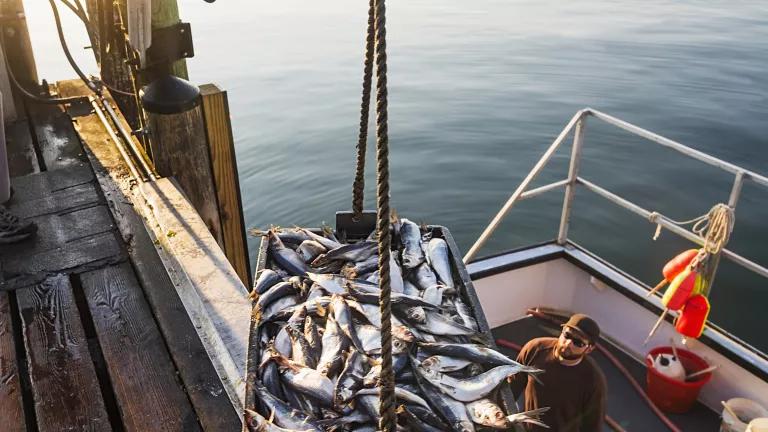Can Anything Be Done to Stop Overfishing?
It’s a complex problem, but a combination of smart fisheries management and consumer vigilance can encourage more sustainable practices.

Billions of people around the world enjoy fish and other forms of seafood; for billions more, they're an essential source of protein. But the methods and practices of many commercial fishing operations are unsustainable in both the long and short terms. Without changing them, the world runs the risk of losing entire species to overfishing, upsetting the delicate balance of ocean ecosystems, and putting the physical and economic health of coastal communities at risk.
The stats are bleak: One-third of fish populations worldwide are overexploited or dangerously depleted. And in some cases, overfishing has altered complex marine ecosystems, creating a ripple effect down food chains. The effects are hidden and often difficult to study. When we clear hundreds of acres of rainforest, we can see the devastation, but it’s much harder to witness the depletion of sea life beneath the waves.
Fortunately, there’s hope. Molly Masterton, an NRDC attorney who works to promote healthy marine management, says that huge policy strides have been made toward restoring and maintaining sustainable fisheries—the lifeblood of many coastal communities and an essential element for healthy oceans. “We have come to a point where we needn’t accept overfishing as an unavoidable effect of fishing in our ocean,” she says. “But reining it in requires governments to employ science-based tools and stick-to-it-iveness.”
As Congress stalls, climate change accelerates
The United States is a global leader in sustainable fishing. The country has already passed such laws as the Magnuson-Stevens Act, which has helped marine species—like Atlantic sea scallop and haddock—rebound after chronic overfishing throughout the 1980s and ’90s. Unfortunately, the law is in dire need of updating and reauthorization, something that last took place in 2006. Congressional members of both parties acknowledge the strength and importance of Magnuson-Stevens, but still have to wade through the details of reauthorization. Strong proposals to build on the act’s successes have been introduced in recent years, such as the Sustaining America’s Fisheries for the Future Act, which, if passed, would help meet the changing needs of fisheries and coastal communities in the face of climate change.
Since the Magnuson-Stevens Act’s passing in 1976, climate change has joined overfishing as a major threat to fisheries. Rising ocean temperatures are causing some fish populations to relocate, while others are dwindling as they struggle to adapt. Every year that fishery managers don’t integrate climate change into their management process threatens the sustainability of the fishery as well as the communities that rely on it. NRDC is not only working to have the Magnuson-Stevens Act respond to climate change, but to strengthen it against proposals that would strip protections for fish populations and endangered species. (You can help by contacting your members of Congress to show your support for healthy fisheries and healthy oceans.)
What can I do to fight against overfishing?
The United States is also a top seafood importer—a unique position that allows the country to influence global practices. Americans consumed close to 6.3 billion pounds of seafood in 2019, about 90 percent of which was imported—often from countries without rigorous fishing laws. (Roughly a third of the global seafood harvest comes from fishing operations engaged in illegal, unreported, and unregulated fishing practices.) Federal “traceability standards,” like the U.S. government’s Seafood Import Monitoring Program, help shed light on unlawful fishing practices and reduce our consumption of illegal products. Before the implementation of this program in 2016, as much as 32 percent of our wild-caught seafood imports came from illegal fishing.
Government policies are essential for shaping best practices at sea, but we as consumers also have a role to play. NRDC’s Smart Seafood Buying Guide offers suggestions for what to consider when visiting the fish counter, and the Monterey Bay Aquarium’s Seafood Watch app is a comprehensive, science-based guide that can help you make sound decisions around what types of seafood to buy. Because supporting sustainable options with your dollar is critical.
Ultimately, Masterton says, smart fisheries management can help shrinking fish populations recover—and the United States and NRDC have been at the forefront of those efforts. But she also cautions that despite laws like the Magnuson-Stevens Act, there remains much work to be done. Nearly three dozen U.S. fisheries are still in the process of recovering from overfishing, and systemic problems like bycatch (the unintended catching of other wildlife) and damage to marine habitat remain.
That’s why NRDC and our partners aren’t giving up the fight anytime soon. Because policies to protect marine ecosystems benefit us all—those of us who enjoy seafood for dinner, and those of us whose livelihood depends on it.
This NRDC.org story is available for online republication by news media outlets or nonprofits under these conditions: The writer(s) must be credited with a byline; you must note prominently that the story was originally published by NRDC.org and link to the original; the story cannot be edited (beyond simple things such as grammar); you can’t resell the story in any form or grant republishing rights to other outlets; you can’t republish our material wholesale or automatically—you need to select stories individually; you can’t republish the photos or graphics on our site without specific permission; you should drop us a note to let us know when you’ve used one of our stories.

Biodiversity 101
How to Become a Community Scientist
Saving Big Mammals Fights Extinction and Climate Change